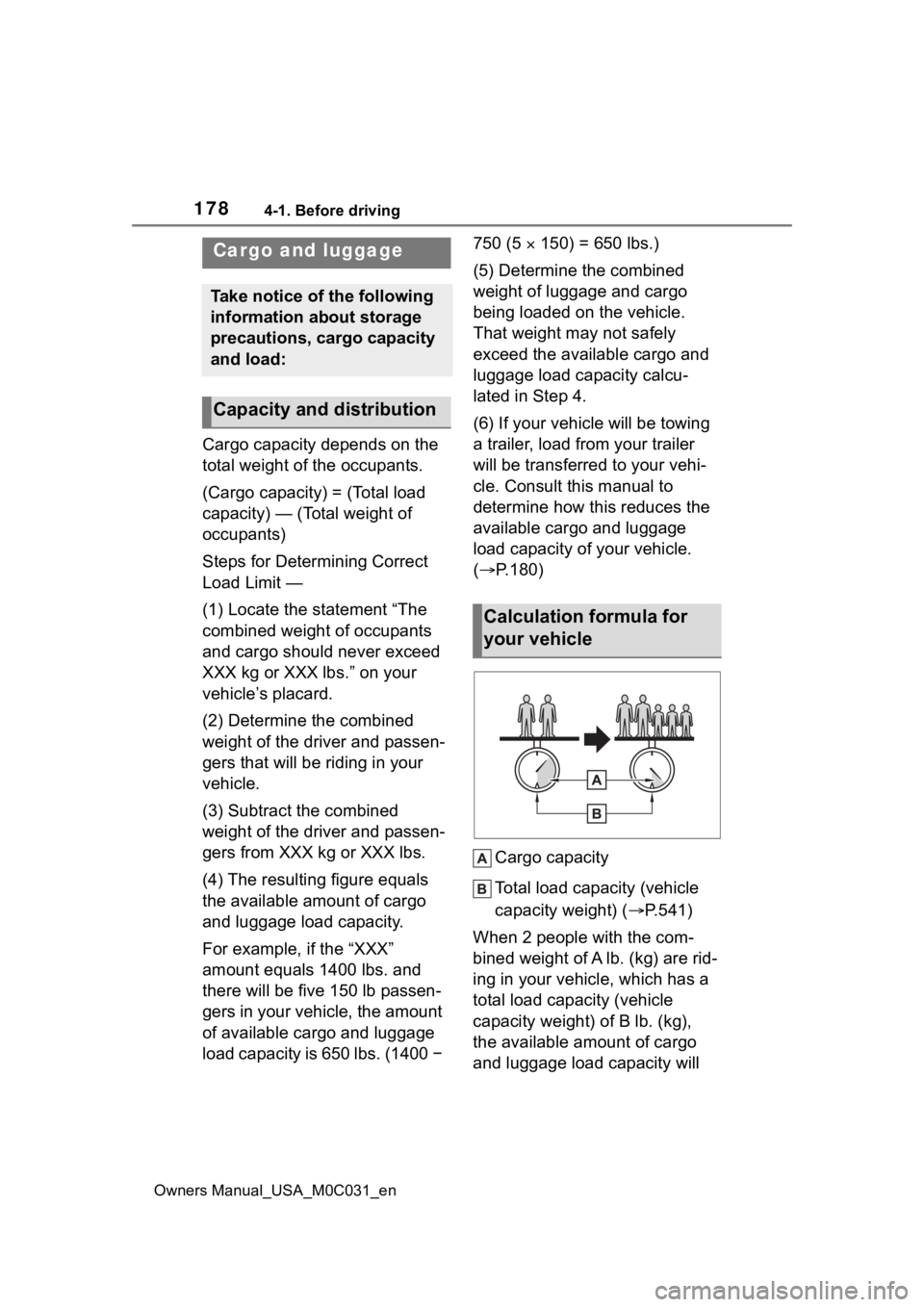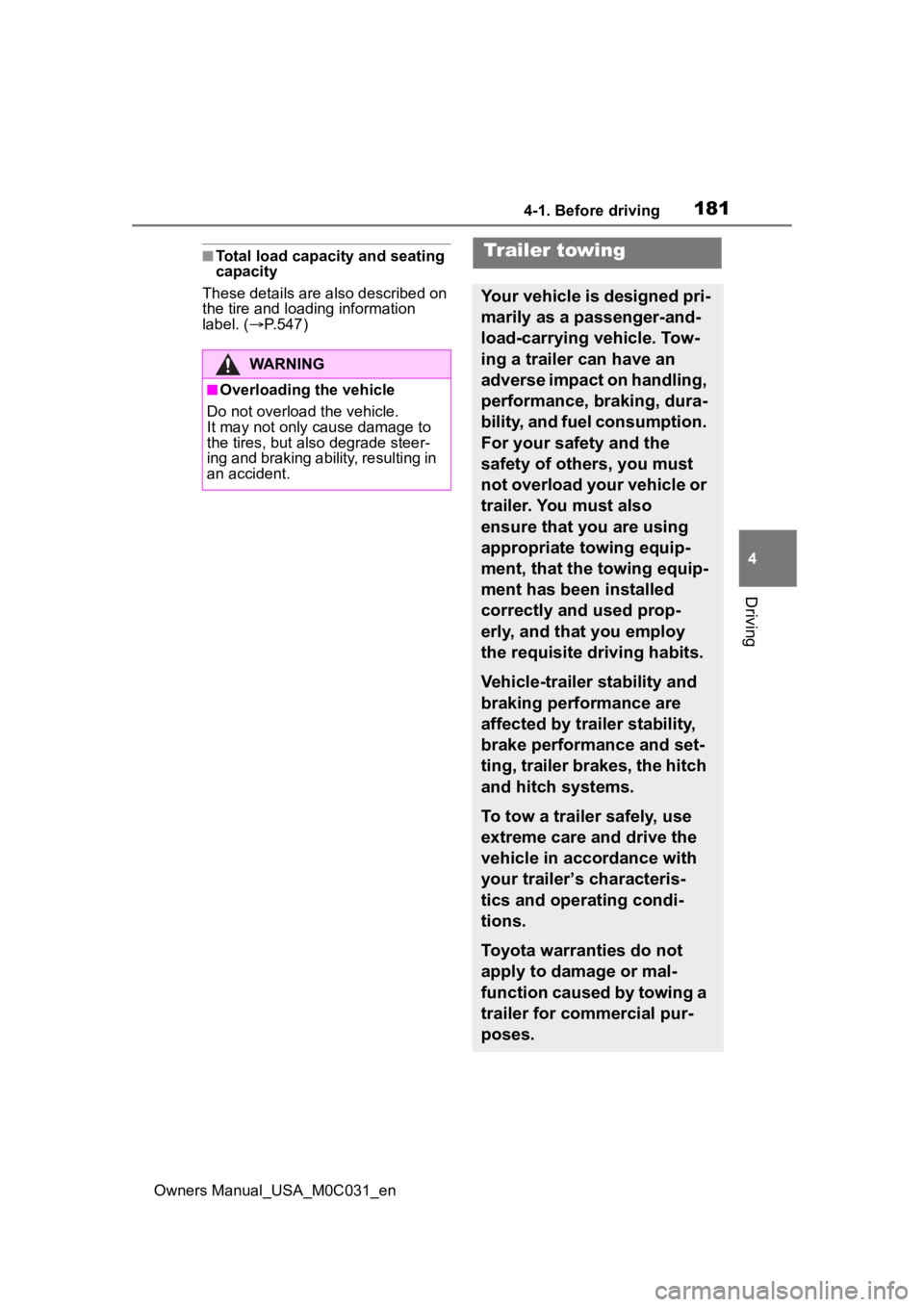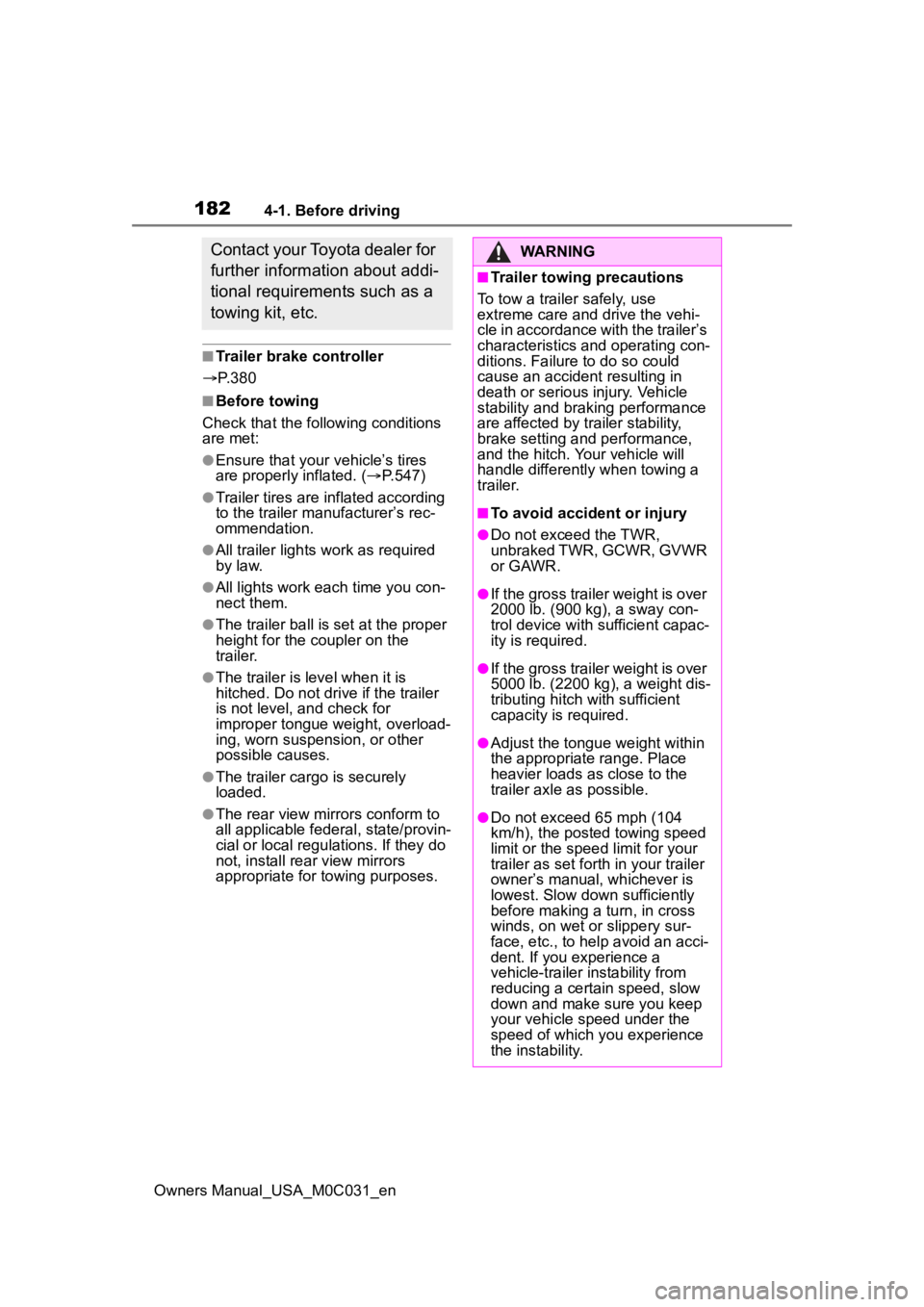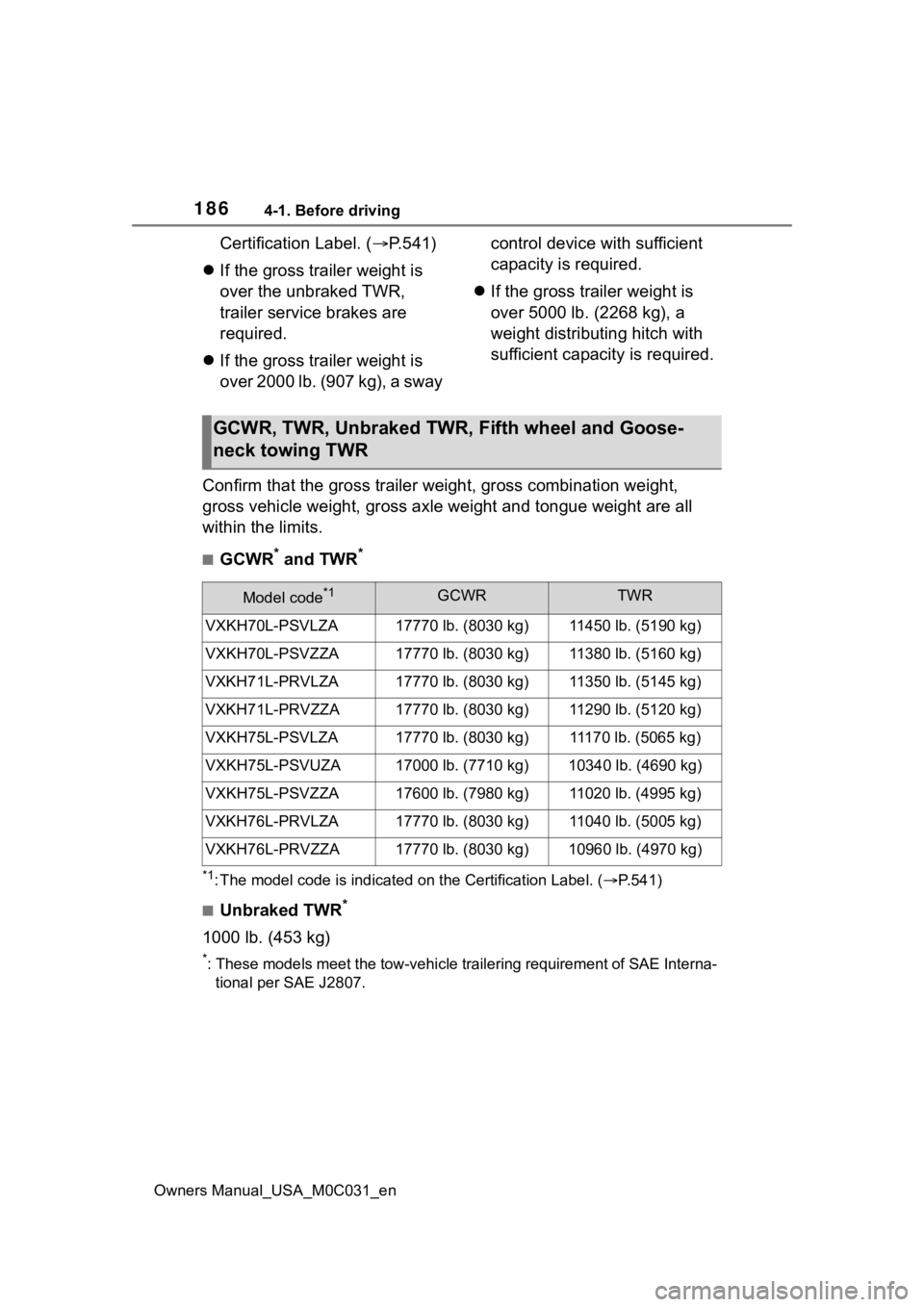2022 TOYOTA TUNDRA HYBRID towing capacity
[x] Cancel search: towing capacityPage 178 of 618

1784-1. Before driving
Owners Manual_USA_M0C031_en
Cargo capacity depends on the
total weight of the occupants.
(Cargo capacity) = (Total load
capacity) — (Total weight of
occupants)
Steps for Determining Correct
Load Limit —
(1) Locate the statement “The
combined weight of occupants
and cargo should never exceed
XXX kg or XXX lbs.” on your
vehicle’s placard.
(2) Determine the combined
weight of the driver and passen-
gers that will be riding in your
vehicle.
(3) Subtract the combined
weight of the driver and passen-
gers from XXX kg or XXX lbs.
(4) The resulting figure equals
the available amount of cargo
and luggage load capacity.
For example, if the “XXX”
amount equals 1400 lbs. and
there will be five 150 lb passen-
gers in your vehicle, the amount
of available cargo and luggage
load capacity is 650 lbs. (1400 − 750 (5
150) = 650 lbs.)
(5) Determine the combined
weight of luggage and cargo
being loaded on the vehicle.
That weight may not safely
exceed the available cargo and
luggage load capacity calcu-
lated in Step 4.
(6) If your vehicle will be towing
a trailer, load from your trailer
will be transferred to your vehi-
cle. Consult this manual to
determine how this reduces the
available cargo and luggage
load capacity of your vehicle.
( P.180)
Cargo capacity
Total load capacity (vehicle
capacity weight) ( P.541)
When 2 people with the com-
bined weight of A lb. (kg) are rid-
ing in your vehicle, which has a
total load capacity (vehicle
capacity weight) of B lb. (kg),
the available amount of cargo
and luggage load capacity will
Cargo and luggage
Take notice of the following
information about storage
precautions, cargo capacity
and load:
Capacity and distribution
Calculation formula for
your vehicle
Page 181 of 618

1814-1. Before driving
Owners Manual_USA_M0C031_en
4
Driving
■Total load capacity and seating
capacity
These details are also described on
the tire and loading information
label. ( P.547)
WARNING
■Overloading the vehicle
Do not overload the vehicle.
It may not only cause damage to
the tires, but also degrade steer-
ing and braking ability, resulting in
an accident.
Trailer towing
Your vehicle is designed pri-
marily as a passenger-and-
load-carrying vehicle. Tow-
ing a trailer can have an
adverse impact on handling,
performance, braking, dura-
bility, and fuel consumption.
For your safety and the
safety of others, you must
not overload your vehicle or
trailer. You must also
ensure that you are using
appropriate towing equip-
ment, that the towing equip-
ment has been installed
correctly and used prop-
erly, and that you employ
the requisite driving habits.
Vehicle-trailer stability and
braking performance are
affected by trailer stability,
brake performance and set-
ting, trailer brakes, the hitch
and hitch systems.
To tow a trailer safely, use
extreme care and drive the
vehicle in accordance with
your trailer’s characteris-
tics and operating condi-
tions.
Toyota warranties do not
apply to damage or mal-
function caused by towing a
trailer for commercial pur-
poses.
Page 182 of 618

1824-1. Before driving
Owners Manual_USA_M0C031_en
■Trailer brake controller
P. 3 8 0
■Before towing
Check that the following conditions
are met:
●Ensure that your vehicle’s tires
are properly inflated. ( P.547)
●Trailer tires are inflated according
to the trailer manufacturer’s rec-
ommendation.
●All trailer lights work as required
by law.
●All lights work each time you con-
nect them.
●The trailer ball is set at the proper
height for the coupler on the
trailer.
●The trailer is level when it is
hitched. Do not dri ve if the trailer
is not level, and check for
improper tongue weight, overload-
ing, worn suspension, or other
possible causes.
●The trailer cargo is securely
loaded.
●The rear view mirrors conform to
all applicable federal, state/provin-
cial or local regu lations. If they do
not, install rear view mirrors
appropriate for towing purposes.
Contact your Toyota dealer for
further information about addi-
tional requirements such as a
towing kit, etc.WARNING
■Trailer towing precautions
To tow a traile r safely, use
extreme care and drive the vehi-
cle in accordance with the trailer’s
characteristics and operating con-
ditions. Failure to do so could
cause an accident resulting in
death or serious injury. Vehicle
stability and brak ing performance
are affected by trailer stability,
brake setting and performance,
and the hitch. Your vehicle will
handle differently when towing a
trailer.
■To avoid accident or injury
●Do not exceed the TWR,
unbraked TWR, GCWR, GVWR
or GAWR.
●If the gross trailer weight is over
2000 lb. (900 kg), a sway con-
trol device with sufficient capac-
ity is required.
●If the gross trailer weight is over
5000 lb. (2200 kg), a weight dis-
tributing hitch with sufficient
capacity is required.
●Adjust the tongue weight within
the appropriate range. Place
heavier loads as close to the
trailer axle as possible.
●Do not exceed 65 mph (104
km/h), the posted towing speed
limit or the spee d limit for your
trailer as set forth in your trailer
owner’s manual, whichever is
lowest. Slow down sufficiently
before making a turn, in cross
winds, on wet or slippery sur-
face, etc., to hel p avoid an acci-
dent. If you experience a
vehicle-trailer instability from
reducing a certain speed, slow
down and make sure you keep
your vehicle speed under the
speed of which you experience
the instability.
Page 186 of 618

1864-1. Before driving
Owners Manual_USA_M0C031_en
Certification Label. (P.541)
If the gross trailer weight is
over the unbraked TWR,
trailer service brakes are
required.
If the gross trailer weight is
over 2000 lb. (907 kg), a sway control device with sufficient
capacity is required.
If the gross trailer weight is
over 5000 lb. (2268 kg), a
weight distributing hitch with
sufficient capacity is required.
Confirm that the gross trailer we ight, gross combination weight,
gross vehicle weight, gross axle weight and tongue weight are all
within the limits.
■GCWR* and TWR*
*1: The model code is indicated o n the Certification Label. (P.541)
■Unbraked TWR*
1000 lb. (453 kg)
*: These models meet the tow-vehicle trailering requirement of SA E Interna-
tional per SAE J2807.
GCWR, TWR, Unbraked TWR, Fifth wheel and Goose-
neck towing TWR
Model code*1GCWRTWR
VXKH70L-PSVLZA17770 lb. (8030 kg)11450 lb. (5190 kg)
VXKH70L-PSVZZA17770 lb. (8030 kg)11380 lb. (5160 kg)
VXKH71L-PRVLZA17770 lb. (8030 kg)11350 lb. (5145 kg)
VXKH71L-PRVZZA17770 lb. (8030 kg)11290 lb. (5120 kg)
VXKH75L-PSVLZA17770 lb. (8030 kg)11170 lb. (5065 kg)
VXKH75L-PSVUZA17000 lb. (7710 kg)10340 lb. (4690 kg)
VXKH75L-PSVZZA17600 lb. (7980 kg)11020 lb. (4995 kg)
VXKH76L-PRVLZA17770 lb. (8030 kg)11040 lb. (5005 kg)
VXKH76L-PRVZZA17770 lb. (8030 kg)10960 lb. (4970 kg)
Page 606 of 618

608Alphabetical Index
Owners Manual_USA_M0C031_en
TRAC (Traction Control) ........ 375
Traction battery (hybrid battery) ................................................. 76Hybrid battery (traction battery) air intake vents ..................... 79
Location.................................. 76
Specification ......................... 543
Warning message .................. 79
Traction Control (TRAC) ........ 375
Traction motor (electric motor)73 Specification ......................... 543
Trailer Backup Guide ............. 383 Canceling the system ........... 386
Precautions .......................... 387
Procedure............................. 383
Setup (Calibration) ............... 384
Trailer hitch light ................... 386
Using Guidance mode.......... 385
Using Straight Path Assist .... 385
Trailer brake ............................ 380
Trailer brake controller .......... 380 Trailer settings ...................... 100
Trailer hitch light ............ 386, 410 Replacing light bulbs ............ 490
Trailer settings ........................ 100
Trailer Sway Control .............. 375
Trailer towing .......................... 181 Trailer Backup Guide............ 383
Trailer settings ...................... 100
Trailering light Replacing light bulbs ............ 490
Transfer ................................... 545
Transmission Automatic transmission ........ 200
Trip meters ................................ 93
Turn signal lights.................... 204 Replacing light bulbs ............ 490
Turn signal lever ................... 204
U
USB charging ports................ 420
V
Vanity lights ............................431
Vanity mirrors .........................431
Vehicle capacity weight .........541
Vehicle data recording ...............7
Vehicle identification number541
Vehicle information display .....98
Ventilators (seat ventilators) .407
Voltmeter ...................................91
W
Warning buzzersApproach warning ................263
Brake hold ............................506
Brake Override System ........505
Brake system ........................501
Charging system ..................502
Downshifting .........................203
Drive-Start Control ................505
Electric power steering .........503
Engine ..................................502
Hands off steering wheel warn- ing (LTA) .............................251
Hybrid system .......................502
Intuitive parking assist ..280, 504
Low engine oil pressure .......502
LTA (Lane Tracing Assist) ...242, 245, 504
Open door .................... 114, 116
Open window........................161
PCS (Pre-Collisio n System) .503
PKSB (Parking Support Brake) ...........................................504
Pre-collision braking .............230
Pre-collision warn ing ............230
RCTA (Rear Cross Traffic Alert) ...................................282, 505
Seat belt ...............................507
SRS airbag ...........................502
Vehicle sway warning function (LTA) ...................................251